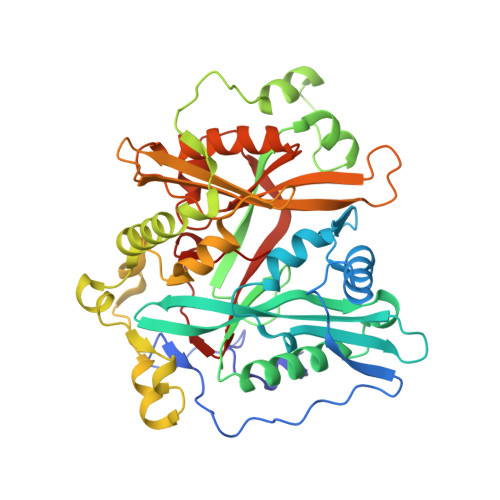Identification of and Structural Insights into Hit Compounds Targeting N -Myristoyltransferase for Cryptosporidium Drug Development.
Fenwick, M.K., Reers, A.R., Liu, Y., Zigweid, R., Sankaran, B., Shin, J., Hulverson, M.A., Hammerson, B., Fernandez Alvaro, E., Myler, P.J., Kaushansky, A., Van Voorhis, W.C., Fan, E., Staker, B.L.(2023) ACS Infect Dis 9: 1821-1833
- PubMed: 37722671
- DOI: https://doi.org/10.1021/acsinfecdis.3c00151
- Primary Citation of Related Structures:
8FBM, 8FBT, 8FBU - PubMed Abstract:
Each year, approximately 50,000 children under 5 die as a result of diarrhea caused by Cryptosporidium parvum , a protozoan parasite. There are currently no effective drugs or vaccines available to cure or prevent Cryptosporidium infection, and there are limited tools for identifying and validating targets for drug or vaccine development. We previously reported a high throughput screening (HTS) of a large compound library against Plasmodium N -myristoyltransferase (NMT), a validated drug target in multiple protozoan parasite species. To identify molecules that could be effective against Cryptosporidium , we counter-screened hits from the Plasmodium NMT HTS against Cryptosporidium NMT. We identified two potential hit compounds and validated them against Cp NMT to determine if NMT might be an attractive drug target also for Cryptosporidium . We tested the compounds against Cryptosporidium using both cell-based and NMT enzymatic assays. We then determined the crystal structure of Cp NMT bound to Myristoyl-Coenzyme A (MyrCoA) and structures of ternary complexes with MyrCoA and the hit compounds to identify the ligand binding modes. The binding site architectures display different conformational states in the presence of the two inhibitors and provide a basis for rational design of selective inhibitors.
- Seattle Structural Genomics Center for Infectious Disease (SSGCID), Seattle, Washington 98109, United States.
Organizational Affiliation:






















